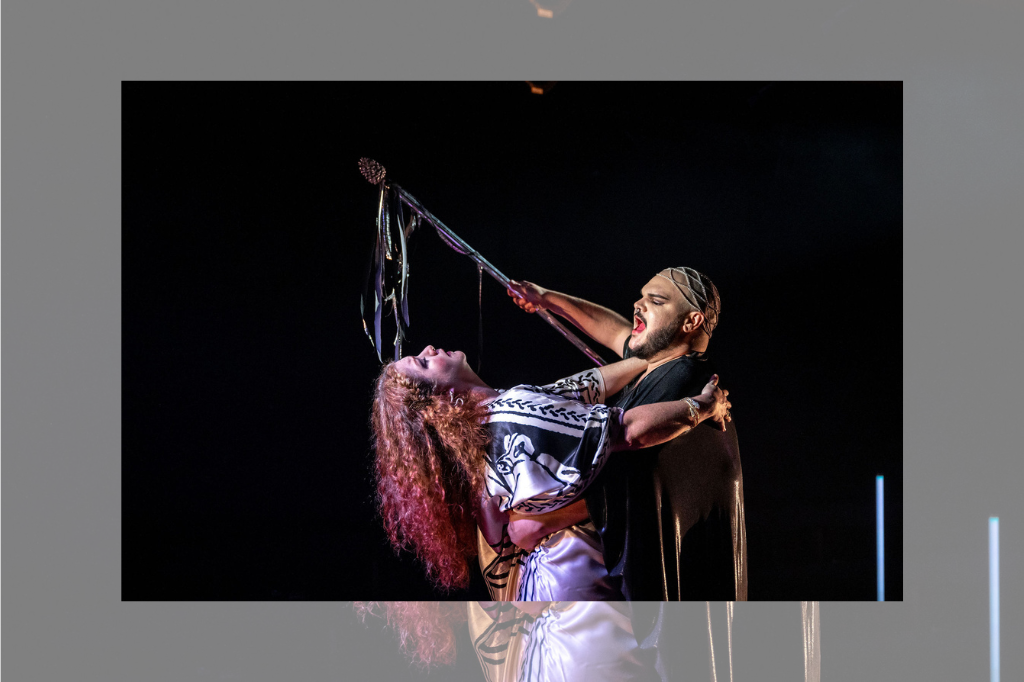REVIEW: Dion: A Rock Opera is a cask of theatrical ecstasy in need of further fermentation
Since being pushed east by a September 2022 fire, Coal Mine Theatre has put up several productions with links to the world of film and TV. Yerma marked the stage debut of David Cronenberg collaborator Sarah Gadon, while Appropriate gave Gray Powell, a star of the CBC sitcom Sort Of, the chance to return to theatre after a four-year hiatus. The press release for The Effect flexed playwright Lucy Prebble’s writing credits on Succession, just as The Sound Inside writer Adam Rapp’s CV includes experience directing three full-length films. Skilful acting in the realist vein defined these striking productions, all dramas; one might well draw a parallel between the intimacy of the Coal Mine space and that of a camera’s frame.
The company’s world premiere presentation of Ted Dykstra and Steven Mayoff’s uneven Dion: A Rock Opera (based on The Bacchae, Euripides’ classic tragedy about Dionysus) signifies a major aesthetic swerve. As befits a show centred on the god of dramatics, Peter Hinton-Davis’ production is highly theatrical, driven largely by the communal energy of its nine-person cast. The show produces an otherworldly atmosphere and luxuriates in the Dionysian with glorious style. But it never quite progresses from adjective to verb: Dion doesn’t just bask in vibes, it nearly drowns in them.
Dykstra and Mayoff follow The Bacchae’s narrative lead. Pentheus (Allister MacDonald), tyrannical ruler of an unnamed city, arrives home from a trip to discover that a strange fever has seized many of his citizens; they guzzle wine and coat the hills in stampedes of violent ecstasy. Turns out this is thanks to non-binary demigod Dion (Jacob MacInnis), who’s in town to take revenge against Pentheus for telling a lie about Semele, mother of the former and aunt of the latter. A few scattered lines about technology indicate the setting has been updated, though this engagement is more-or-less meatless, only ever reaching the point of allusion.
The sung-through score wears its influences — rock operas from the 1960s and ‘70s — proudly. Jesus Christ Superstar (JCS) is the obvious touch point: both use medium-tempo music to slow down ancient stories, with each song providing a drawn-out dramatization of a moment that passes quicker in its source. This approach emphasizes the structural similarities between pop songs and operatic arias (their reliance on repetition, their single-mindedness). It can also lead to dramatic stagnancy if the music isn’t exciting enough.
And indeed, in the case of Dion, the melodies of the solo lines are sometimes a touch dry. The very interesting choral arrangements, along with a few catchy refrains (like JCS, the best one involves the title: “Dion, Dion, Dion, my god, Dioooon!”), are instead what keep the show moving. (Music director Bob Foster leads the three-piece band with momentum, although I found the orchestrations surprisingly piano-heavy.)
Set and costume designer Scott Penner places Dion on a narrow alley stage with a thin, red-brick runway extending parallel to the audience and up the walls. A pair of pedestaled white humanoid sculptures stand on opposite ends of the playing space, backs to the action, each facing a circular mirror. The work of lighting designer Bonnie Beecher is stylized, abounding in isolations and colour. Penner’s edgy, leather-forward costumes echo Brian De Palma’s cult classic musical film Phantom of the Paradise. And glowing rods illuminate shadowy choreographic sequences by Kiera Sangster that bring to mind Cameron Carver’s fiery contributions to Jillian Keiley’s Richard II at the Stratford Festival.
Hinton-Davis’ attention to duration is what makes him one of Canada’s best living directors. In the exquisite The Man That Got Away (A Special Appearance) at Buddies in Bad Times Theatre, for instance, he interrogated the cabaret form by drawing out sequences that one would expect to pass quickly and speeding up ones that might ordinarily take a while. There are a few short chunks of Dion where movement comes to the fore and such explorations are begun — but they’re quickly interrupted by the need to return to Dykstra and Mayoff’s score, which lumbers forward at a reasonably consistent pace. The result: a production that occasionally feels confined by the music.
A couple of the performers — MacInnis, in a sensitive star turn, along with ensemble member Saccha Dennis — are able to break free from these constraints, delivering appropriately liberated (appropriately Bacchic?) vocals. But others, like MacDonald, have to fight to keep up.
Dion’s ideas ravish, and its visuals engulf. How wonderful to see the Coal Mine filled with queerness, sensuality, and mayhem. Theatricality! Bacchanalia! “Evoe!” But it now feels time to bring the figurative camera back — not to mute the stimulating aesthetic, but to zoom in and find a focus.
Dion: A Rock Opera runs at Coal Mine Theatre until March 3. Tickets are available here.
Intermission reviews are independent and unrelated to Intermission’s partnered content. Learn more about Intermission’s partnership model here.















Comments